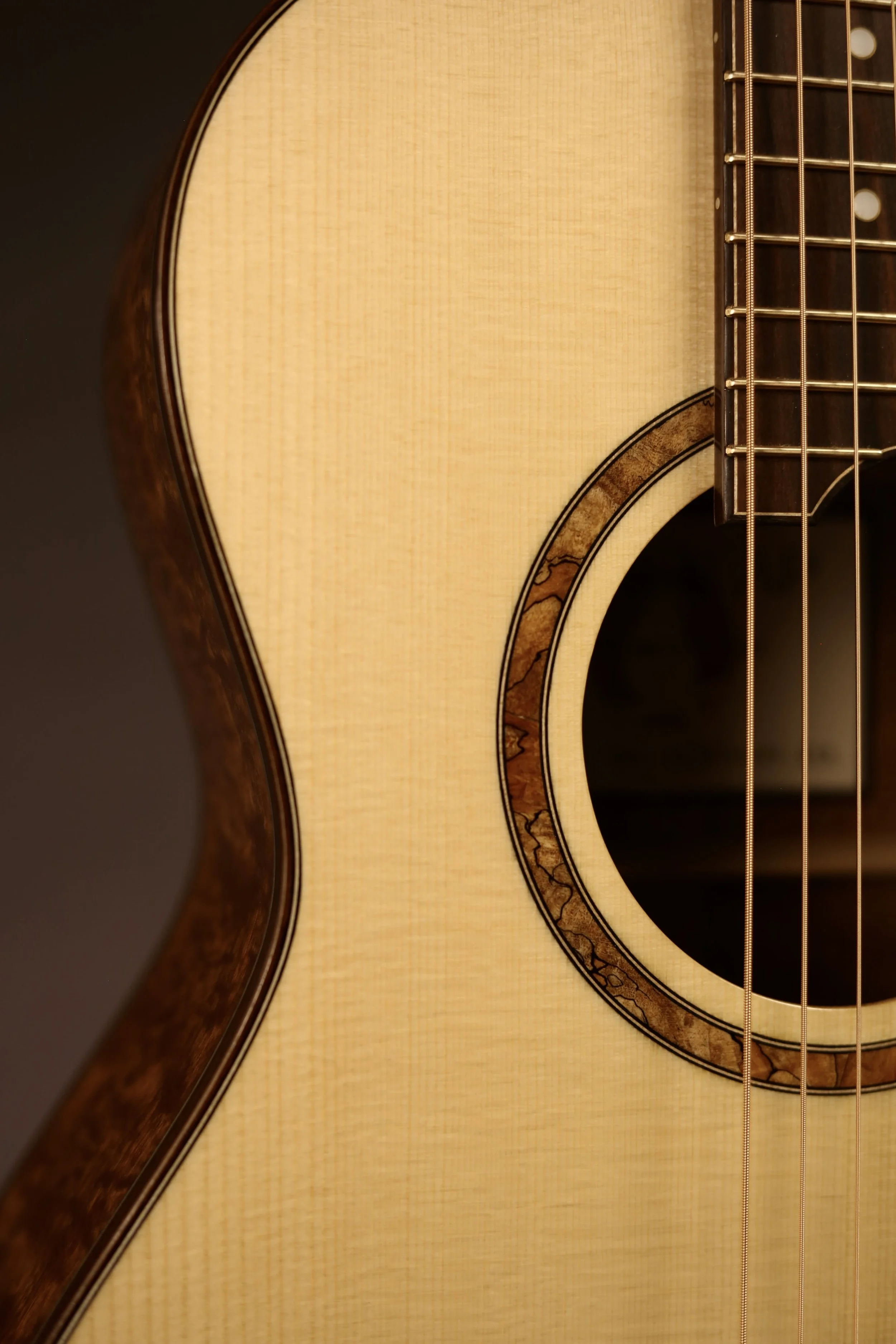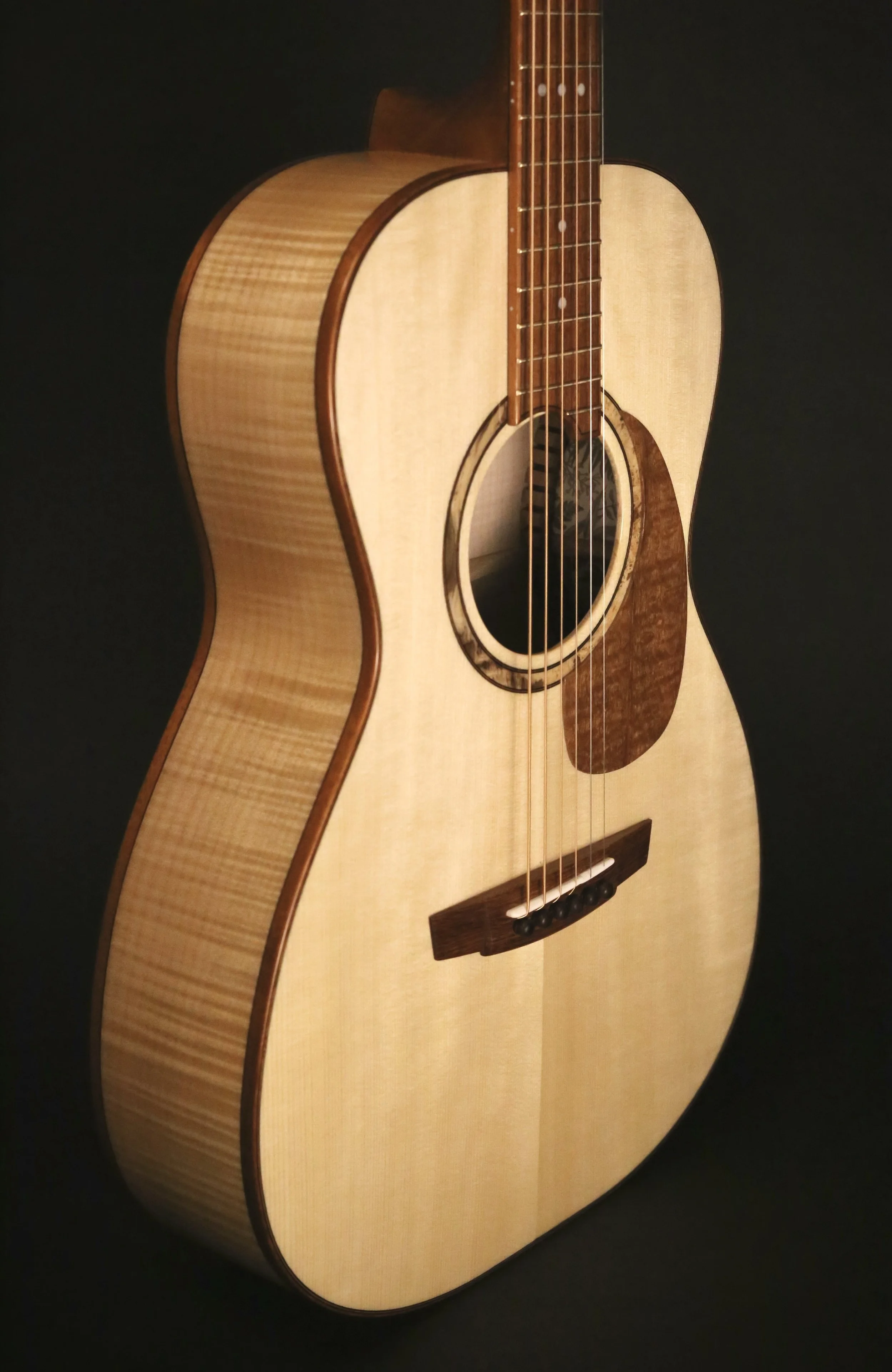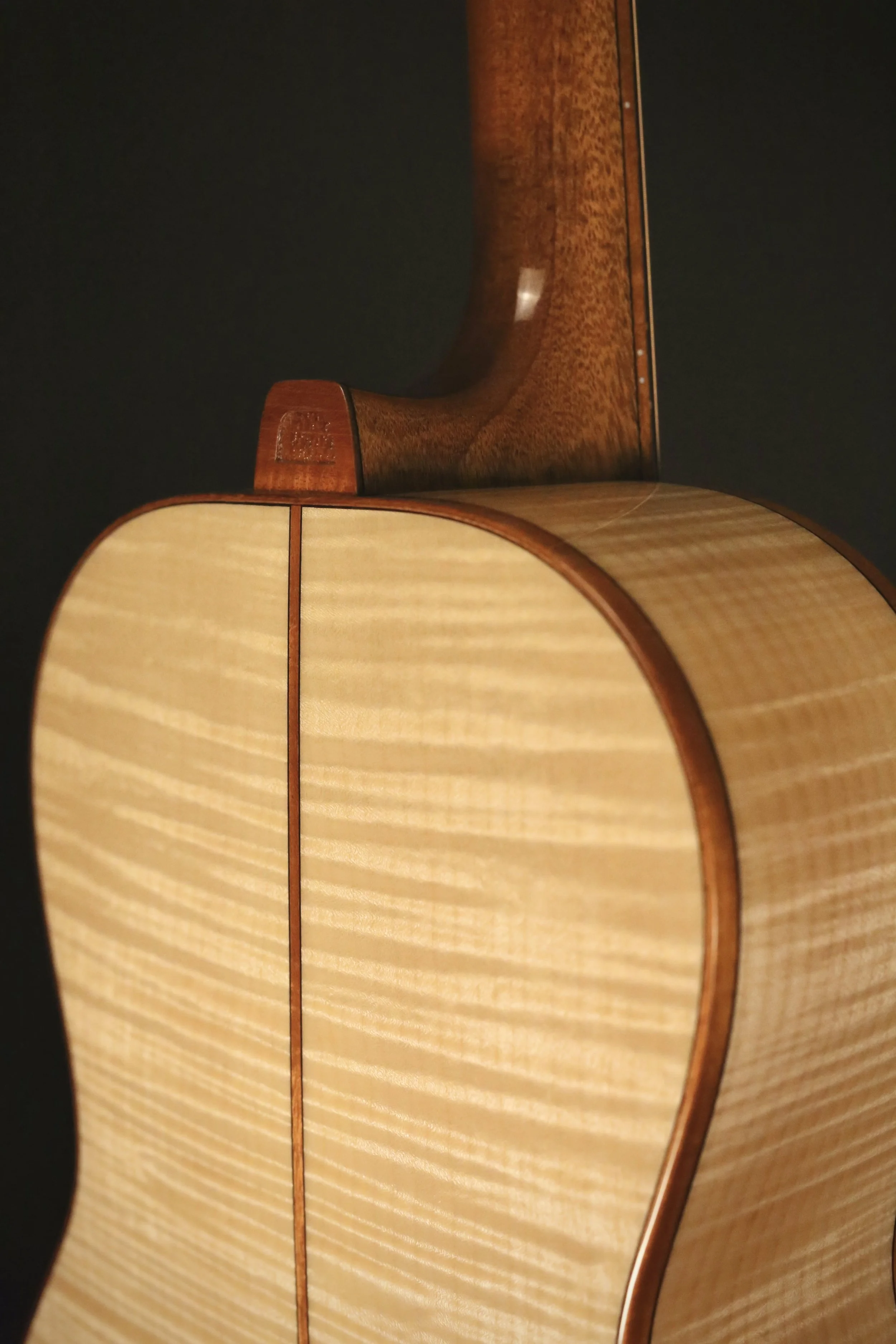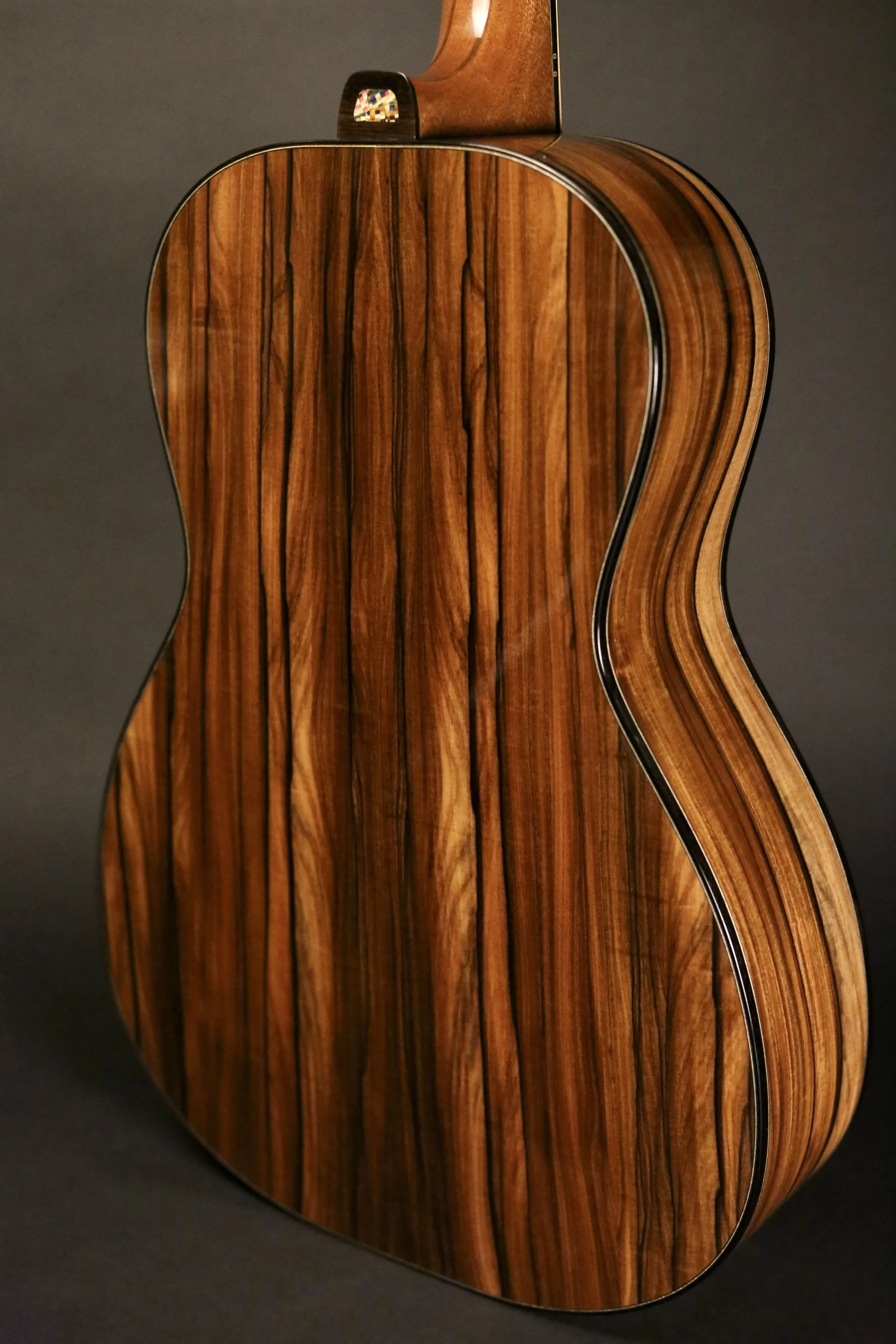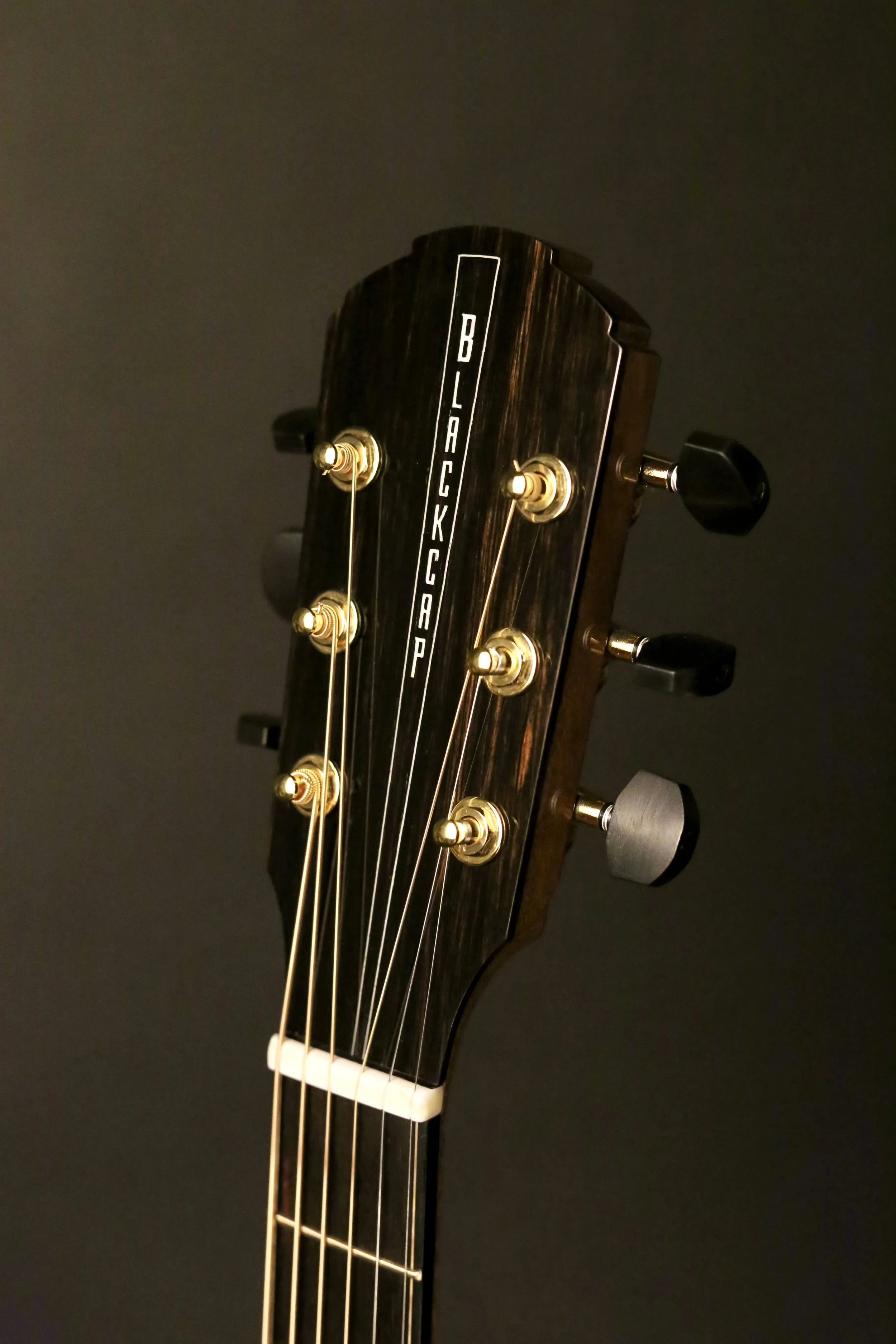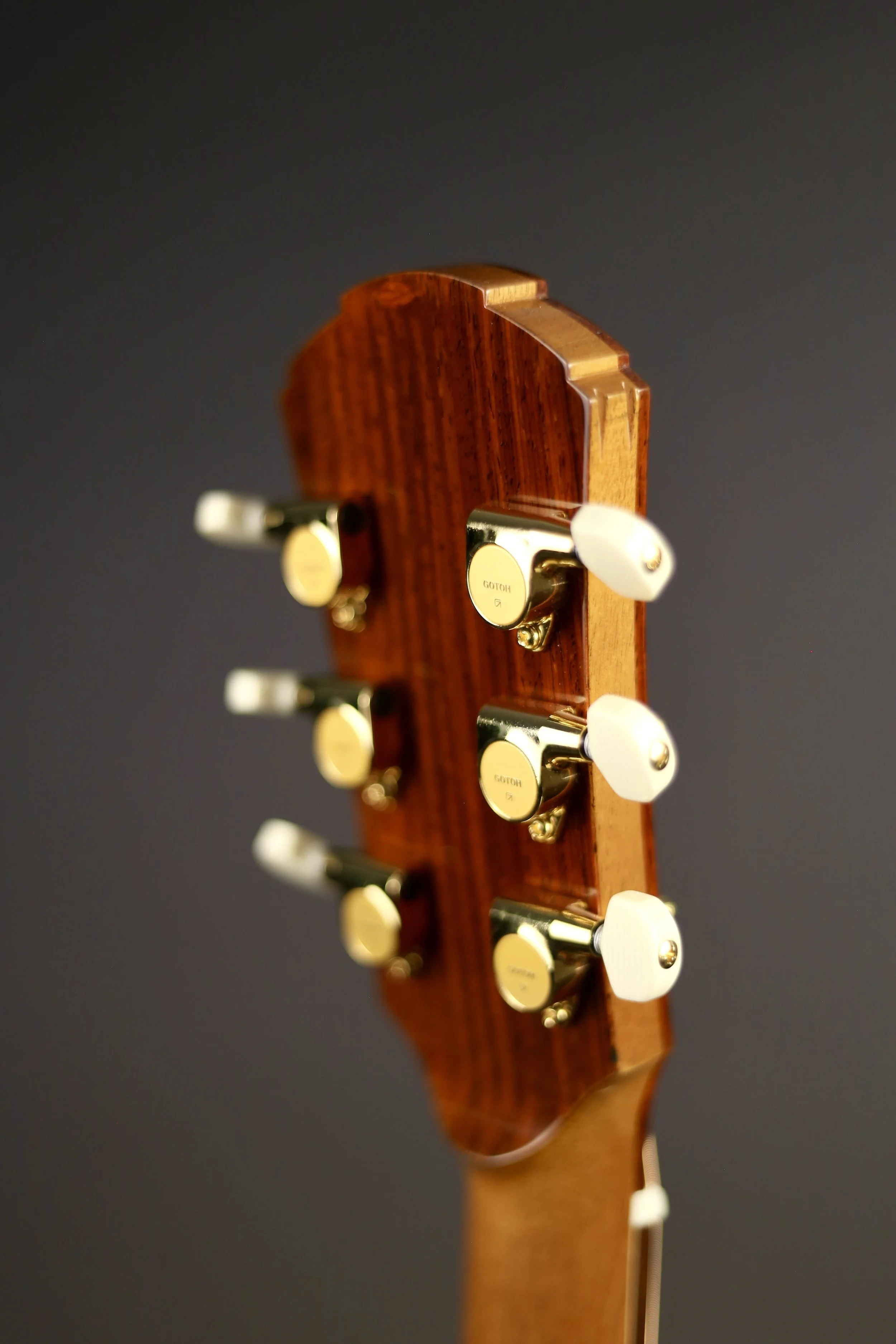
Tonewoods
Guitar Tops
-
Adirondack Spruce
Many people consider Adirondack Spruce to be one of the finest options for steel string soundboards. It has a powerful, clear tone which makes it a popular choice for bluegrass players and strummers but is equally at home with lighter fingerpickers. It has strong, punchy mids and is open and even from bass to treble. Adirondack Spruce is warm white in color, and generally has wider grain lines than other types of spruce, which creates a visually striking and recognizable appearance.
-

Sitka Spruce
Easily the most common steel string tone wood, Sitka Spruce is a great “all around” soundboard choice. It has a responsive attack and can stand up to heavy strumming as well as fingerpicking, although a lighter touch can sometimes sound a little thin. It has strong mids and treble, as well as a resonant low end, without sounding overly boomy. Sitka generally has straight, tight grain, and from time to time can be found with visually striking “bearclaw” figure in it. Color ranges from pale white and pink to light yellow and gold.
-
Western Red Cedar
Cedar is a traditional choice for classical and flamenco guitars. Its dark, lush tone shares many similarities with Redwood but tends to be a little less bass driven and has slightly more attack. It has a warm tone that features an open mid-range and a clear, bright treble. Cedar is well suited to players with a lighter touch. It is a much softer and lighter wood than Spruce and is ideal for smaller sized guitars. Colors range from light brown and red to honey.
-

Yellow Cedar
Yellow Cedar has a clear and articulate tone with great sustain. It sits somewhere between Red Cedar and Spruce tonally, and is a good choice for fingerpickers and flatpickers alike. Although it sounds great when strummed, it may not have as much volume as some of the Spruces. It has a very even texture and tight, close grain that creates a clean visual look. Colors range from yellow to warm white.
-

Mahogany
Mahogany is a mid-range forward tonewood that lends itself to a warm, punchy traditional feel. It sounds excellent paired with mahogany back and sides, and ages beautifully. It has an organic, “woody” tone that feels comfortable when played in most styles, from heavy strumming to lighter fingerpicking. It oftentimes takes a little more time to open up as a soundboard, but it continually sounds richer as it ages. Colors range from red to yellow often with beautiful straight grain, although highly figured pieces can be found.
-
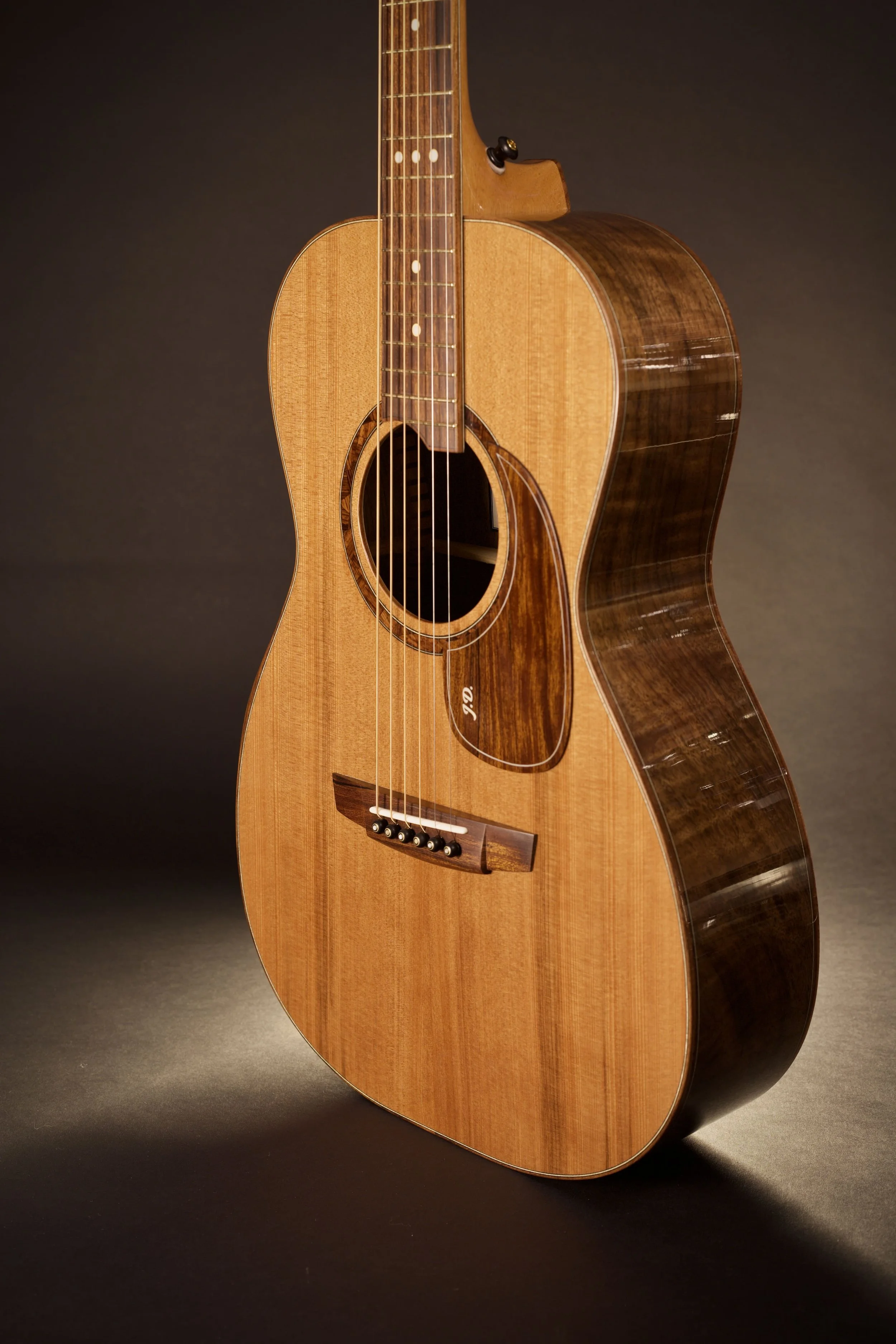
Redwood
Redwood is a low to mid volume tone wood that offers a rich bass and warm mids. It is ideal for fingerpicking and light to mid strumming, which allows its many subtleties and overtones to shine through. It can be highly figured and visually stunning at times, yet generally has tight, straight grain. It’s a strong, yet lightweight tonewood and usually works well with small to mid-sized guitars. Colors range from deep red to chocolate brown.
-

Engelmann Spruce
Engelmann is a popular alternative to Sitka Spruce and tends to offer slightly more complexity when played lightly. It typically has slightly less headroom and is well suited for players who play on the softer side yet desire an open, clear tone. It features a rich mid-range and has a somewhat more mature tone than Sitka. It has uniform growth rings and a clean, pale white appearance.
-
Carpathian Spruce
Another fantastic Spruce option is Carpathian Spruce. Very similar to Adirondack in tone, it has a very natural, warm, woody sound to it, with a quick response, and beautiful note separation that’s ideal for almost all playing styles. It features open, even lows, but sometimes leans slightly more towards the mids and highs. Visually, it is a nice creamy white, with slightly wider grain lines, that can be both subtle, as well as quite striking, depending on the particular piece.
Torrefaction
-

Torrefaction
Torrefaction is a process of baking wood in a high temperature, oxygen-free kiln which quickly ages wood in a controlled setting. A newly torrefied guitar top has many of the same tonal and visual attributes as a well-aged, vintage instrument. While it tends to make the wood slightly more brittle, it offers the unique advantage of stabilizing the wood and making it less prone to movement and cracking due to changes in environment. Torrefaction can be done on the guitar top and interior bracing.
Back and Sides
-

Mahogany
Mahogany is one of the most popular options for acoustic back and sides. It has a warm, natural tone that pushes the mid range, and works well for almost all playing styles. It feels balanced when paired with just about any top wood and is one of the rare tonewoods that can be matched fully as a top, back and sides. It ages nicely, both tonally and visually. It has simple, yet beautiful, red to gold coloring and straight grain, although some highly figured pieces can be found.
-

Indian Rosewood
Indian Rosewood is a classic acoustic guitar tone wood. It is quick and responsive, highly resonant and is ideal for fingerpicking and strumming alike. Though not as mellow as some woods, it has a brilliant and complex tone that projects plenty of bass, yet complements both the mid and high end comfortably. Visually it can have colorful streaks of chocolate brown, purple and black.
-
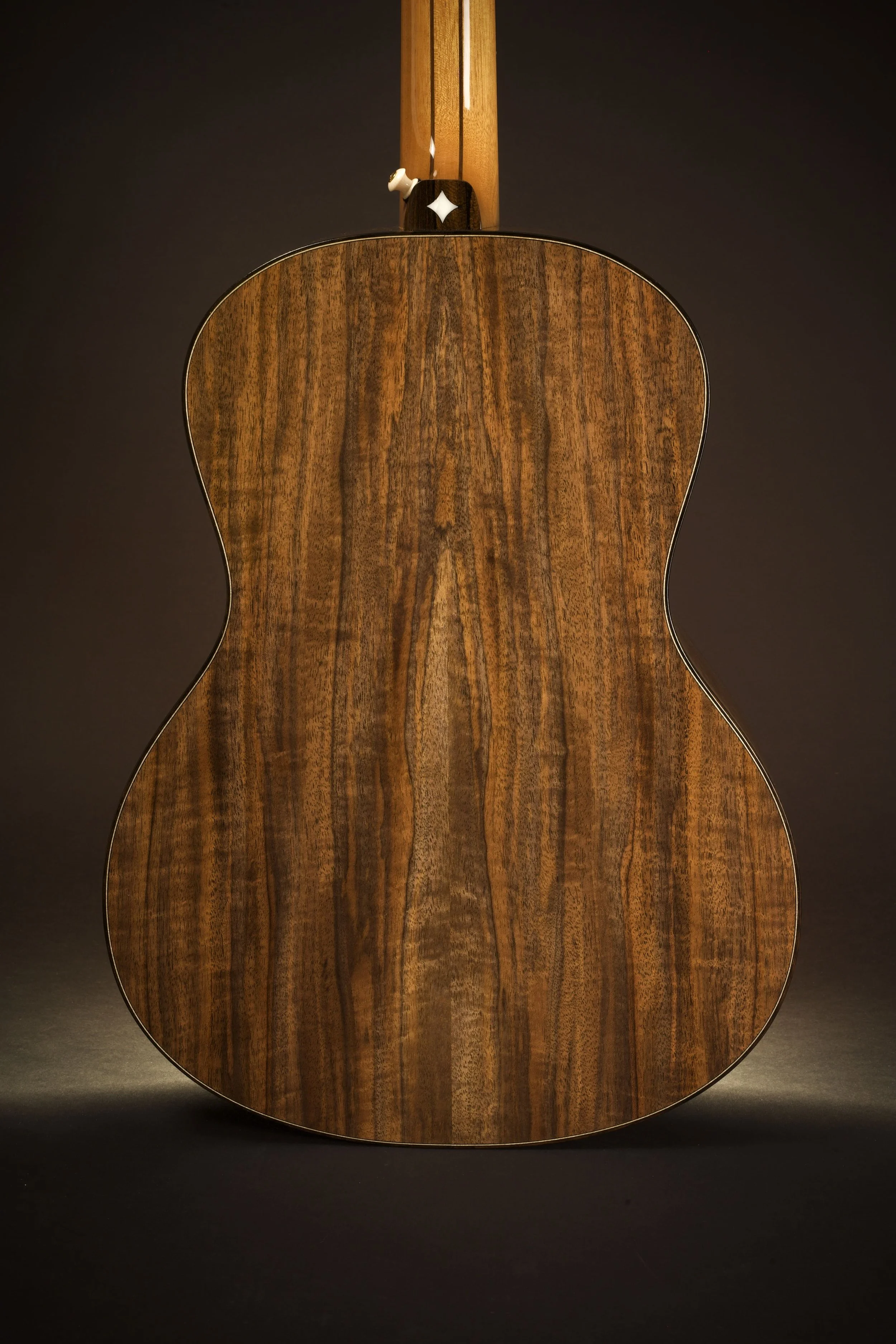
Walnut
Walnut has a balanced and easy tone that lends itself to almost any soundboard wood pairing although it particularly thrives when paired with Redwood and Cedar. It is both warm and bright and falls between Mahogany and Rosewood in both tonality and resonance. Walnut tends to be a rich dark brown and often has beautiful figure ranging from black to grey and sometimes touching on yellow and purple.
-
Maple
A traditional tone wood for violins, cellos and many other stringed instruments, Maple is a beautiful pale white wood that ranges from ivory to light yellow in color and often-times has unparalleled figure. It has a bright and somewhat flat tone with a quick decay that does not lend itself to all environments yet blossoms in many. It is a natural choice in certain amplified settings, as its short note decay is more resistant to feedback than many other tonewoods and works well as the back and sides of large body acoustic guitars for similar reasons.
-
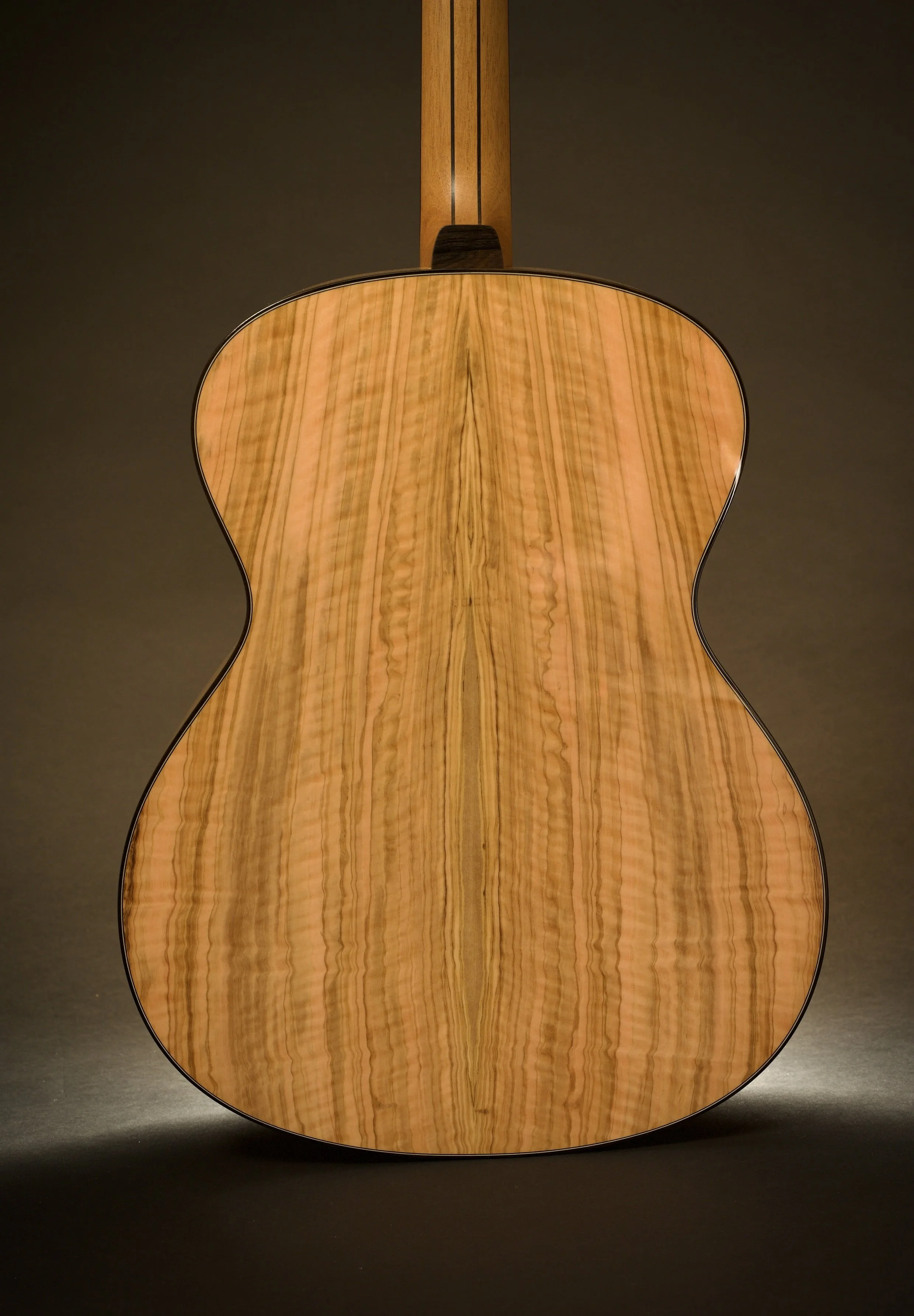
Olivewood
Olivewood has a nice, mellow, natural tone, similar to Mahogany, but with a somewhat softer bottom end. It can be strikingly beautiful, and have many diverse colors throughout it, including yellows, pinks, greys, browns, and greens. It has a warm mid, and low end, with a bright, and woody high end. It works well while playing softly, fingerpicking, as well as mid to heavy strumming, and pairs well with many different top woods.
-
Pau Ferro
Sometimes called Bolivian Rosewood, Pau Ferro shares many similarities, yet is not actually in the Rosewood family. Tonally it sits between Indian Rosewood and Walnut. It has a fast, clean response that captures the lows, mids, and highs evenly, and a natural, percussive attack with excellent clarity. Visually it has a nice, chocolate brown appearance that can be found at times with stripes of black, grey, red, and honey.
-

Bubinga
Bubinga has a very rich, full sound with plenty of bright highs and warm mids. It has very natural, dark overtones with a bright sparkle throughout it. Tonally it shares a lot of similarities with Rosewood and is a fantastic wood for back and sides. It can be incredibly striking visually with red, pink and sometimes purple coloration throughout it and oftentimes can be found with very high figuring.
-

Wenge
Similar to Canarywood, Wenge has a bright, bell-like tone that rivals that of any Rosewood. It has warm, and even mids and lows that provide a very level, open sound as well as a clarity and liveliness that is ideal for flat picking and fingerpicking. It has plenty of volume that works well with just about any soundboard pairing and playing style. Visually it is a dark, chocolate brown to black with golden brown grain lines.
-
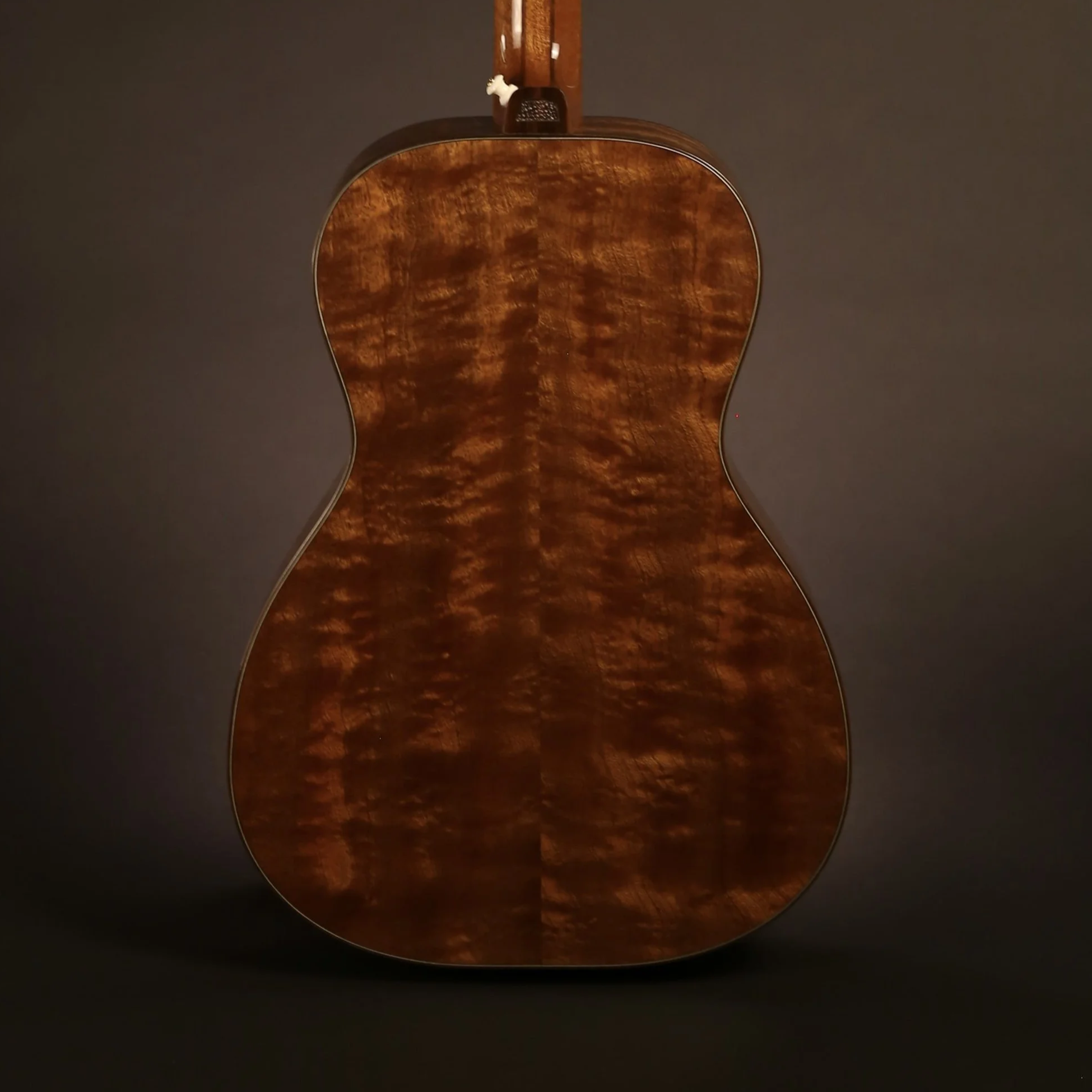
Sapele
Sapele is quite similar to Mahogany in almost every way, but it tends to have a little bit more of a treble zing to it. As a back and sides it can be paired effectively with a Sapele top or with any other top wood. It has a warm, natural tone and ages well. Visually it’s slightly darker than Mahogany and has a nice reddish brown color to it. It typically has relatively straight grain, but highly figured wood can be found as well.
-
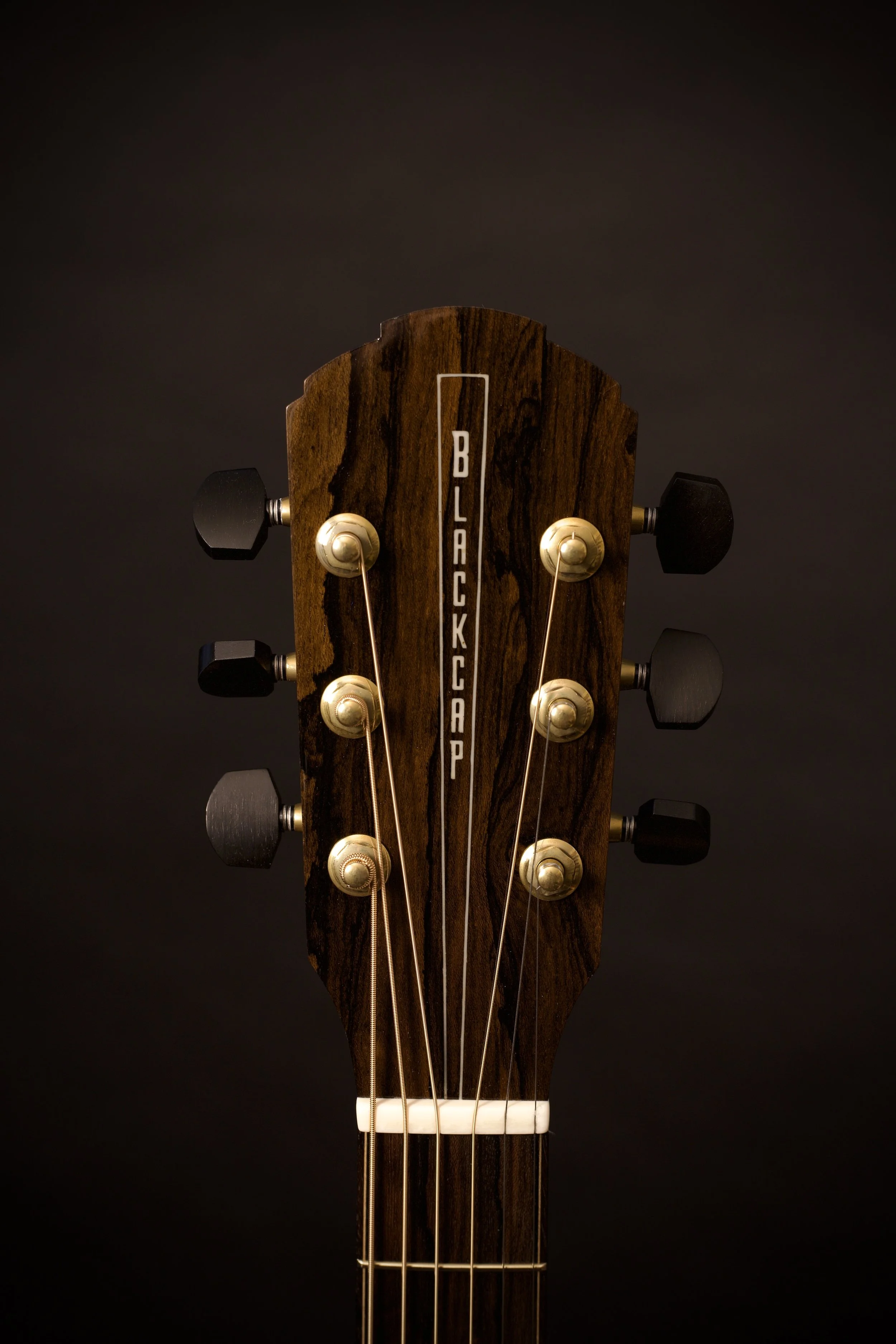
Ziricote
Ziricote is one of the more visually striking woods out there, with a clear, glassy, yet warm tone. It is often referred to as “Mexican Rosewood”, even though it is not in the rosewood family. It lends itself well to fingerpicking, and medium strumming, but also offers plenty of volume when played with higher energy. Visually it can be extraordinarily figured, with striking, black spider webbing, and dark grey, to warm brown hues throughout it. Truly one of the more unique looking woods in the world.
-

Black Limba
Black Limba, sometimes referred to as Korina, is an African hardwood that produces a rich, warm tone similar to Mahogany. It tends to have slightly more clarity than Mahogany and is slightly more balanced from bass to treble. It has good note separation with a somewhat energetic sound. Typically it’s a pale yellow in color with striking black and grey streaks and at times can be found with deep orange figuring throughout it.
-

Canarywood
Canarywood has a bright, bell-like tone to it, reminiscent of Rosewood. It has great sustain and clarity, with plenty of volume to go along with it. It has a somewhat metallic tone with plenty of treble zing, although it’s not lacking in mids or bass. Visually it has a warm yellow coloration and can have a wild array of red, orange, brown, grey and sometimes purple stripes throughout it which darken up through the years.
-

Padauk
Padauk has a strong, punchy tone, along the same lines as a Rosewood. It features a rich, deep bass with strong overtones and even mids. It has relatively short sustain which lends itself to strumming and fingerpicking. It pairs nicely with a Cedar or Redwood top, but can also sound great with Spruce depending on tonal preference. It has a bright red to orange color that darkens in the direction of a warm, cinnamon brown over time.
-

Myrtle
Myrtle has some tonal similarities to Maple, although it tends to be a little more rounded and not quite as sharp. It is clear and bright, with good projection and sustain. It features a warm mid range, a crisp, woody bass and an open treble that translates well to both picking and strumming. Visually it is pale white to yellow, with grey, brown and sometimes green coloration throughout it and can be highly figured at times.
-

Koa
Koa offers a crisp, clear tone and can be paired nicely with many other tonewoods or alone as a Koa top, back and sides . It projects well and tends to be bright and full. It is comfortable when played both loud and soft and opens-up as it ages. It is often highly figured and ranges from a warm honey to a chocolate brown in color.
-

Cherry
Cherry features a nice, open mid range that falls somewhere between Mahogany and Maple. It’s warm and bright, with a somewhat reflective response. It has a clean and articulate tone that sounds nicely balanced with almost all playing styles. Visually, Cherry has a uniform and somewhat understated look, although some figured pieces can be found. It has a light reddish brown hue to it that darkens with age.
Fretboards, Bridges, and Headplates
-
Ebony
Ebony has great sustain, a quick, bright attack and percussive, woody overtones.
-

Pau Ferro
Pau Ferro has a rich, warm, even tone with medium decay and light overtones.
-
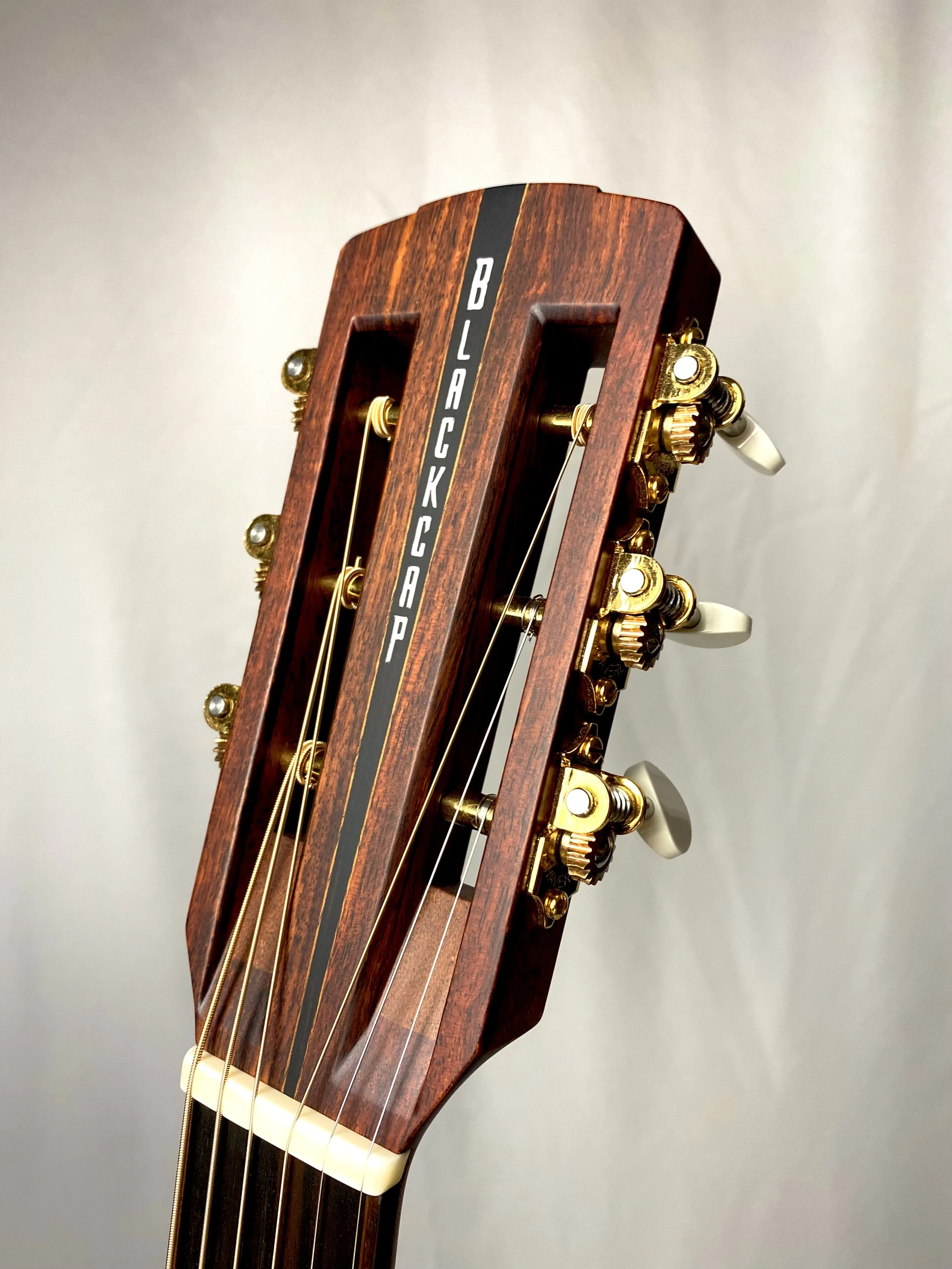
Indian Rosewood
Similar to Pau Ferro, Indian Rosewood features a warm, clean tone with light overtones and moderate decay.
-

Ziricote
Ziricote has warm, yet bright overtones, which sit somewhere between Ebony and Pau Ferro, and offers a natural, woody resonance.
-

Bubinga
Bubinga has a warm, open tone with medium overtones and a clear, strong sustain.
-
Maple
Maple offers medium sustain, a quick tonal response and tight, bright overtones.
-
Cocobolo
Cocobolo has a very musical, crisp, bell-like chime to it, with a bright, fast attack.
-

Wenge
Wenge has a very resonant, clear tone with a quick response and good sustain.
-

Padauk
Padauk is bright and punchy, with a quick attack, short sustain and medium overtones.
Wood Movement
Radial - Thickness, or the movement from the center of the tree towards the outside, like sun rays.
Tangential - Width, or the amount the wood moves along the growth rings, ie. flatsawn direction.
Volumetric - Total, or how much the wood shrinks from green to dried in all directions.
T/R Ratio - Width to depth. The T/R ratio can range from just over 1, to nearly 3. At a T/R ratio of 1, shrinkage would occur in a perfectly uniform manner across the width and thickness of the board. At a T/R ratio of 3, the flatsawn surface would shrink or swell at triple the rate of the quartersawn surface
Janka Hardness - The hardness of a wood measured by the force required to embed a .444” steel ball into the wood by half its diameter.
Lbf - Pound force
-
African Blackwood (Dalbergia melanoxylon)
Shrinkage - Radial: 2.9%, Tangential: 4.8%, Volumetric: 7.7%, T/R Ratio: 1.7
Janka Hardness - 3,670 lbf
Names - Grenadilla, Mpingo
Regions - Central and southern Africa
-
Alder (Alnus glutinosa)
Shrinkage - Radial: 4.4%, Tangential: 7.3%, Volumetric: 12.6%, T/R Ratio: 1.7
Janka Hardness - 590
Names - Western Red Alder
Regions - Western Coastal America
-
Beefwood (Grevillea striata)
Shrinkage - Radial: 3.5%, Tangential: 5.8%, Volumetric: 9.3%, T/R Ratio: 1.7
Janka Hardness - 2,420 lbf
Names - She Oak
Regions - Western Australia
-
Black Limba (Terminalia superba)
Shrinkage - Radial: 4.3%, Tangential: 6.3%, Volumetric: 10.8%, T/R Ratio: 1.5
Janka Hardness - 680 lbf
Names - Limba, White Limba, Korina, Afara
Regions - Western Africa
-
Bubinga (Guibourtia demeusei)
Shrinkage - Radial: 6%, Tangential: 8.2%, Volumetric: 13.9%, T/R Ratio: 1.4
Janka Hardness - 2,410 lbf
Regions - West Africa
-
Canarywood (Centrolobium spp)
Shrinkage - Radial: 2.4%, Tangential: 5.6%, Volumetric: 8.4%, T/R Ratio: 2.3
Janka Hardness - 2,000 lbf
Regions - South America
-
Western Red Cedar (Thuja plicata)
Shrinkage - Radial: 2.4%, Tangential: 5%, Volumetric: 6.8%, T/R Ratio: 2.1
Janka Hardness - 320 lbf
Regions - Pacific Northwest
-
Alaskan Yellow Cedar (Cupressus nootkatensis)
Shrinkage - Radial: 2.8%, Tangential: 6.0%, Volumetric: 9.2%, T/R Ratio: 2.1
Janka Hardness - 580 lbf
Regions - Northwest coastal North American
-
Cocobolo (Dalbergia retusa)
Shrinkage - Radial: 2.7%, Tangential: 4.3%, Volumetric: 7%, T/R Ratio: 1.6
Janka Hardness - 2,960 lbf
Regions - Central America
-
Gaboon Ebony (Diospyros crassiflora)
Shrinkage - Radial: 8.3%, Tangential: 11.2%, Volumetric: 19.6%, T/R Ratio: 1.3
Janka Hardness - 3,080 lbf
Regions - West Africa
-
Macassar Ebony (Diospyros celebica)
Shrinkage - Radial: 4.8%, Tangential: 8.5%, Volumetric: 13.3%, T/R Ratio: 1.9
Janka Hardness - 3,250 lbf
Regions - Southeast Asia
-
Granadillo (Dalbergia melanoxylon)
Shrinkage - Radial: 2%, Tangential: 4%, Volumetric: 6%, T/R Ratio:
Janka Hardness - 2,700 lbf
Regions - Mexico/South America
-
Indian Rosewood (Dalbergia sissoo)
Shrinkage - Radial: 2.7%, Tangential: 5.9%, Volumetric: 8.5%, T/R Ratio: 2.2
Janka Hardness - 2,440 lbf
Regions - India, Shri Lanka/Indonesia
-
Koa (Cyprinus rubrofuscus)
Shrinkage - Radial: 5.5%, Tangential: 6.2%, Volumetric: 12.4%, T/R Ratio: 1.1
Janka Hardness - 1,220 lbf
Regions - Hawaii
-
Honduran Mahogany (Swietenia macrophylla)
Shrinkage - Radial: 2.9%, Tangential: 4.3%, Volumetric: 7.5%, T/R Ratio: 1.5
Janka Hardness - 800 lbf
Regions - Mexico/South America
-
Maple (Acer saccharum)
Shrinkage - Radial: 4.8%, Tangential: 9.9%, Volumetric: 14.7%, T/R Ratio: 1.9
Janka Hardness - 1,450 lbf
Names - Sugar Maple, Hard Maple, Rock Maple
Regions - Northeast North American
-
Mesquite (Prosopis glandulosa)
Shrinkage - Radial: 1.6%, Tangential: 3.2%, Volumetric: 4.8%, T/R Ratio: 2.0
Janka Hardness - 2,345 lbf
names - Honey Mesquite
Regions - South western North America/Mexico
-
White Oak (Quercus alba)
Shrinkage - Radial: 5.6%, Tangential: 10.5%, Volumetric: 16.3%, T/R Ratio: 1.9
Janka Hardness - 1,360 lbf
Regions - Eastern US
-
Olivewood (Olea europaea)
Radial: 4.9%, Tangential: 7.7%, Volumetric: 12.8%, T/R Ratio: 1.6
Janka Hardness - 2,710 lbf
Names - Mediterranean Olive, Italian Olive, European Olive
Regions - Mediterranean
-
Padauk (Pterocarpus soyauxii)
Shrinkage - Radial: 3.3%, Tangential: 5.2%, Volumetric: 7.6%, T/R Ratio: 1.6
Janka Hardness - 1,725 lbf
Names - Vermillion
Regions - Central/Western Africa
-
Pau Ferro (Libidibia ferrea)
Shrinkage - Radial: 2.8%, Tangential: 6.7%, Volumetric: 9.9%, T/R Ratio: 2.4
Janka Hardness - 1,780 lbf
Names - (Morado, Bolivian rosewood, Santos rosewood)
Regions - Brazil/Bolivia
-
Redwood (Sequoia sempervirens)
Shrinkage - Radial: 2.4%, Tangential: 4.7%, Volumetric: 6.9%, T/R Ratio: 2.0
Janka Hardness - 420
Names - Coastal Redwood
Regions - Coastal northwestern US
-
Snakewood (Brosimum guianense)
Shrinkage - Radial: 4.7%, Tangential: 6%, Volumetric: 10.7%, T/R Ratio: 1.3
Janka Hardness - 3,800 lbf
Names - Letterwood
Regions - Northeast South America
-
Spruce (Adirondack) (Picea rubens sarg)
Shrinkage - Radial: 3.8%, Tangential: 7.8%, Volumetric: 11.8%, T/R Ratio: 2.1
Janka Hardness - 490 lbf
Regions - Eastern North America
-
Engelmann Spruce (Picea engelmannii)
Shrinkage - Radial: 3.8%, Tangential: 7.1%, Volumetric: 11.0%, T/R Ratio: 1.9
Janka Hardness - 390 lbf
Regions - Western North America
-
Sitka Spruce (Picea sitchensis)
Shrinkage - Radial: 4.3%, Tangential: 7.5%, Volumetric: 11.5%, T/R Ratio: 1.7
Janka Hardness - 510 lbf
Region - Northwestern US/Canada
-
Teak (Tectona grandis)
Shrinkage - Radial: 2.6%, Tangential: 5.3%, Volumetric: 7.2%, T/R Ratio: 2.0
Janka Hardness - 1,100 lbf
Regions - Africa/Asia/Latin America.
-
Black Walnut (Juglans nigra)
Shrinkage - Radial: 5.5%, Tangential: 7.8%, Volumetric: 12.8%, T/R Ratio: 1.4
Janka Hardness - 1010 lbf
Regions - Eastern US
-
Claro Walnut (Juglans hindsii)
Shrinkage - Radial: 4.3%, Tangential: 6.4%, Volumetric: 10.7%, T/R Ratio: 1.5
Janka Hardness - 1,130 lbf
Regions - West coast US
-
Wenge (Millettia laurentii)
Shrinkage - Radial: 4.8%, Tangential: 8.1%, Volumetric: 12.9%, T/R Ratio: 1.7
Janka Hardness - 1,630 lbf
Regions - Central Africa
-
Ziricote (Cordia angiocarpa)
Shrinkage - Radial: 3.5%, Tangential: 6.7%, Volumetric: 9.8%, T/R Ratio: 1.9
Janka Hardness - 2,100 lbf
Regions - Mexico


